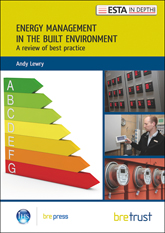
Energy management in the built environment: A review of best practice(FB44) DOWNLOAD
A step-by-step approach to energy management is explained, together with the use of a matrix tool for implementing energy management initiatives within an organisation. The tool can help identify areas for improvement, prioritise energy management activities and maximise benefits. Most of the examples are from the built environment but the principles can be employed in any organisation or industry sector. The guidance is applicable by anyone responsible for energy management in an organisation, from board level to operational staff. In addition, the publication:
- examines how data from sources such as BREEAM assessments, energy audits, energy performance certificates, display energy certificates and monitoring and targeting can underpin energy management
- addresses asset and operational performance and discusses how information from both is needed to adequately assess the energy performance of a building
- illustrates how undertaking an energy management programme can improve energy ratings
introduces the new energy management standard ISO 50001 and explains its contribution to an auditable energy management programme.
Executive summary
1 Introduction - why manage energy?
2 Energy management systems
3 Establishing the facts
- Site master planning
- Asset and operational ratings
4 Utility bills and metering
5 Monitoring and targeting (M&T)
- Initial data analysis
- More complicated analysis
- Targets, reporting and actions
6 Energy surveys, audits and walk-arounds
7 Installation, commissioning and maintenance
8 Action plan and option appraisal
9 Financial appraisal
10 Implementation and monitoring
11 Review, lessons learnt and continuous improvement
References
Appendices: Energy management matrices; BREEAM 2011 energy monitoring standard
A4 48pp
Available on or after 17/1/2012.
